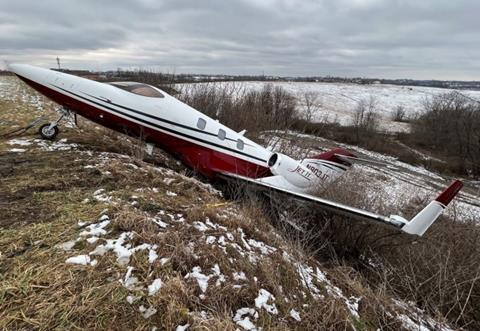US investigators have found that a Honda Aircraft HA-420 had been flying faster than the prescribed approach speed during descent, before it landed long and overran a slush-contaminated runway at Pittsburgh’s Allegheny County airport.
The business jet, with two pilots and a passenger, had been arriving from Teterboro airport on 9 March 2022.
It had been travelling at 11kt above the calculated reference speed as it descended through 1,000ft during its ILS approach to runway 28.
Although this was in line with operator limits, the aircraft’s thrust levers and engine speeds were at idle – contrary to its stabilised-approach requirement that thrust should not be idle, but set in accordance with the aircraft configuration.
The operator’s procedures demanded that crews respond to an unstable approach with a go-around.
Analysis determined the aircraft crossed the threshold at 131kt, about 9kt faster than the reference, and touched down 2,300ft along the 6,500ft runway.
Although the aircraft began to decelerate, the captain called for maximum braking when he realised it was not slowing sufficiently to stop on the remaining runway.
He attempted to steer the jet to the left, and applied the emergency brake. The aircraft hydroplaned, skidding sideways and overrunning the runway end.

The runway was situated on a plateau with terrain dropping steeply about 100ft off the western end.
During the excursion the aircraft travelled tail-first over the incline, and came to rest in trees, suffering substantial damage to the wings and fuselage, including a rupture of its centre fuel tank, as well as its tyres.
The US National Transportation Safety Board says the braking friction coefficient achieved was lower than that implied by wet-runway landing distances in the aircraft flight manual.
Simulations show the aircraft (N903JT) might have stopped in time if it had achieved this coefficient, and would even have stopped 850ft before the runway end had it achieved the coefficient specified by the US FAA runway condition assessment matrix.
None of the three occupants was injured.
Examination and testing of the brake system, including its hydraulic pressure and anti-skid features, showed no failures or unusual behaviour.


























